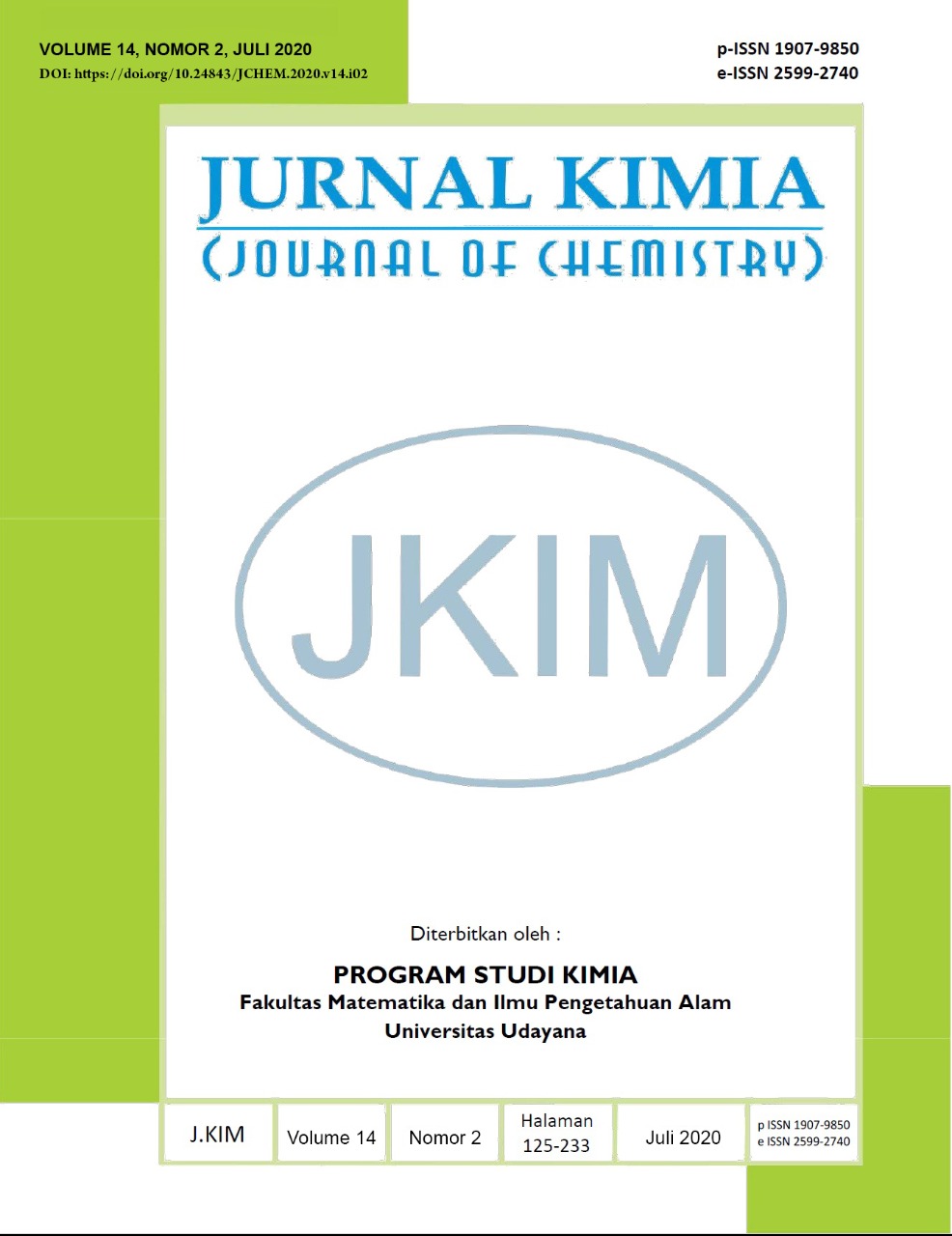SPESIASI DAN BIOAVAILABILITAS LOGAM BERAT DALAM SEDIMEN SUNGAI ROOMO GRESIK
Abstract
Aliran Sungai Roomo telah tercemar oleh bahan-bahan organik terutama dari limbah domestik dan industri.Cemaran logam berat juga dipastikan ada dalam sungai tersebut.Logam berat ini masuk ke dalam sedimen dan biota yang hidup di lingkungan tersebut dan dapat terakumulasi pada seluruh bagian tubuhnya.Tujuan penelitian ini adalah untuk menentukan tingkat pencemaran logam Pb, Cd, dan Cu dalam air dan sedimen Sungai Roomo Gresik serta menganalisis biovailabilitas logam berat tersebut.Metode ekstraksi bertahap dan digesti basah digunakan untuk melakukan spesiasi dan ekstraksi logam dari sedimen serta konsentrasi logamnya diukur menggunakan Spektrofotometer Serapan Atom (AAS). Kandungan logam Pb, Cd, dan Cu dalam aliran sungai Roomo Gresik telah melebihi batas yang diperbolehkan, yaitu berturut-turut 1,6038-7,8365 mg/L; 0,0251–0,0798 mg/L; dan 0,1709–0,2249 mg/L dalam air dan 213,7750–539,0763 mg/kg; 3,3467–39,7071 mg/kg; dan 36,9168-190,7079 mg/kg dalam sedimen. Pola spesiasi logam berat tersebut sebagai F1 atau fraksi EFLE (easily, freely, leachable, exchangeable), F2 (reducible), F3 (oxidisable), dan F4 (resistant) adalah sebagai berikut: F4 > F2 > F1 > F3 untuk Pb dan Cd, sedangkan Cu dengan pola F3 > F4 > F2 > F1. Logam Pb, Cd, dan Cu yang bioavailable berturut-turut 2,78-7,11%, 1,98-20,44%, dan 2,48-13,66%, sementara yang berpotensi bioavailable berturut-turut 10,05-16,81%; 9,41-54,44%; dan 15,18-94,19%. Logam Pb, Cd, dan Cu yang non bioavailable berturut-turut 79,53-84,22%, 25,11-86,04%, dan 1,84-80,67%. Dengan demikian, Sungai Roomo Gresik telah tergolong sebagai sungai yang tercemar.
Kata kunci: biavailabilitas, logam berat, sedimen, spesiasi, sungai
The Roomo River Stream has been polluted by organic materials which were mainly from domestic and industrial waste. Heavy metals were also ensured contaminated the river. These heavy metals enter sediments and can accumulate in the biota living in the river. This study was aimed to determine the level of pollution of Pb, Cd, and Cu metals in the water and sediments of the Roomo Gresik River and to analyze the biovability of these heavy metals. The sequential extraction and wet digestion method were used to perform a speciation and extraction of the metals from sediments. The concentration of the metals was measured by the use of Atomic Absorption Spectrophotometer (AAS). The contents of Pb, Cd, and Cu metals in the river were exceeded the allowed limit, which were 1.6038-7.8365 mg/L; 0.0251-0.0798 mg/L; and 0.1709-0.2249 mg/L, respectively in water and 213.7750-539763 mg/kg; 3.3467–39.7071 mg/kg; and 36.9168-190.7079 mg/kg, respectively in sediments. The pattern of heavy metal speciations as F1 or EFLE fraction (easily, freely, leachable, exchangeable), F2 (reducible), F3 (oxidizable), and F4 (resistant) were as follows: F4>F2>F1>F3 for Pb and Cd, whereas Cu with the pattern of F3>F4>F2>F1. The percentages of bioavailability of Pb, Cd, and Cu metals including readily biavailable were 2.78-7.11%, 1.98-20.44%, and 2.48-13.66%, potentially bioavailable were 10.05-16.81%, 9.41-54.44%, and 15.18-94.19%. Non-bioavailable were 79.53-84.22%, 25.11-86.04% and 1.84-80.67%, respectively. Therefore, the Roomo Gresik River has been classified as a polluted river.
Keywords: bioavailability, heavy metals, river, sediment, speciation
Downloads
References
Bernard, T. and Neff, J. 2001. Metals Bioavailability in the Navy’s Tiered Ecological Risk Assesment Process, Issue Paper, Washington Navy Yard, page 1-15.
Damanhuri, E.,dan Tri, P. 2010. Diktat Kuliah Pengelolaan Sampah. Institut Teknologi Bandung, Bandung.
Darmono. 1995. Logam Dalam Sistem Biologi Makhluk Hidup. Universitas Indonesia Press, Jakarta.
Fajri, N. E. 2001. Analisis Kandungan Logam Berat Hg, Cd, dan Pb Dalam Air Laut, Sedimen, dan Tiram (Carassostrea cucullata) di Perairan Pesisir Kecamatan Peder Kabupaten Karawang Jawa Barat. Tesis. Fakultas Pascasarjana IPB, Bogor.
Gasparatos, D., Haidouti, C., Andrinopoulus and Areta, O. 2005. Chemical Speciation and Bioavailability of Cu, Zn, and Pb in Soil from The National Garden of Athens, Greece, Proceedings: International Conference on Environmental Science and Technology, Rhodes Island.
Lu, F. C. 1995. Toksikologi Dasar UI Press: Jakarta.
Ma’ruf. 2007. Adaptasi Konsentrasi Logam Berat pada Ikan Baronang (Siganus sp) dan Lingkungan Perairan untuk Pengolahan Wilayah Pesisisr Bontang. Tesis. Universitas Mulawarman.
Pascoli, C. 1999. Nature Waters and Water Technology. Italy.
Siaka, M., C. M. Owens, G. F. Birch. 1998. Evaluation of Some Digestion Methods for The Determination of Heavy Metal in Sediment Samples by Flame-AAS, Analytical Letters. 31(4):703-718.
Siaka, I M., Utama, I M.S., Manuaba, I. B. P,.and Adnyana, I M. 2016. Speciation and Bioavailability of Some Heavy Metals in Agricultural Soils Used for Cultivating Various Vegetables in Bedugul, Bali. AIP Conference Proceedings: 5th International Conference and Workshop on Basic and Applied Sciences (ICOWOBAS 2015). 1718 pp. 050005-1-050005-11.
Suryati. 2011. Analisa Kandungan Logam Pb dan Cu dengan Metode Spektrofotometri Serapan Atom Terhadap Ikan Baung (Hemibagrus nemurus) di Sungai Kampar Kanan Desa Muara Takus Kecamatan XIII Koto Kampar Kabupaten Kampar, Jurnal Ilmiah Mahasiswa UIN Sultan Syarif Kasim Riau, 10(3): 23-31.
Yap, C.K., Ismail, A., dan Tan, S.G., 2003, Concentration, Distribution and Geochemical Speciation of Copper in Surface Sediment of the Strait of Malacca, Pakistan Journal of Biological Science, 6(12): 1021-1026.
Zulfitri. 1998. Pemanfaatan Mikroorganisme Sebagai Salah Satu Alternatif Pengolahan Limbah Industri, Jurnal Lingkungan dan Pembangunan, Pusat Studi Lingkungan Perguruan Tinggi Seluruh Indonesia: Jakarta.

This work is licensed under a Creative Commons Attribution 4.0 International License






